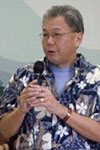
Ann-Laura Parks
Ever come back from a conference inspired, energized, and ready to unleash your brilliant ideas on your colleagues? You’re cruising along on a creative high until you hear, “That’s a good idea BUT…” followed by the reasons why it can’t be done.
When yours truly was a young worker bee, I heard some reasons that made head/desk contact a regular occurrence:
“We don’t need a blog. Nobody reads those. They are just vanity projects for people with big egos.” - executive director of a large nonprofit
“Why on earth would we ever want to post anything on YouTube?” - marketing director at a federal agency
More likely, though, you’ll hear something like, “I’d love to but we just can’t spare the money/time/staff for that.”
If you want to avoid the quick, early death of your idea, getting the go ahead from the authorizers in your organization will be your first challenge.
Read More















 Elias Gross
Elias Gross

 Ariel Fielding
Ariel Fielding

 Andy Horwitz
Andy Horwitz

 Annie Wu
Annie Wu

 Janet Starke
Janet Starke


 Elaine Maslamani
Elaine Maslamani

 Jill Robinson
Jill Robinson

 Al Stilo
Al Stilo

 Ann-Laura Parks
Ann-Laura Parks

 Gerald Yoshitomi
Gerald Yoshitomi

 Brianne Logan
Brianne Logan

 Jordan Silton
Jordan Silton
 Chris McLeod
Chris McLeod

 Amelia Northrup-Simpson
Amelia Northrup-Simpson

 Jim McCarthy
Jim McCarthy

 Jeff Poulin
Jeff Poulin

 Over the past few weeks, a new face has been popping up at street fairs and food festivals across the country: an Amazon “food truck,” doling out Kindle Fires alongside neighboring trucks’ hot dogs, hamburgers, and artisanal cupcakes.
Over the past few weeks, a new face has been popping up at street fairs and food festivals across the country: an Amazon “food truck,” doling out Kindle Fires alongside neighboring trucks’ hot dogs, hamburgers, and artisanal cupcakes.
 Sean King
Sean King




